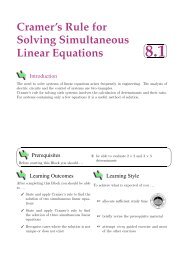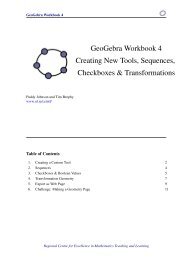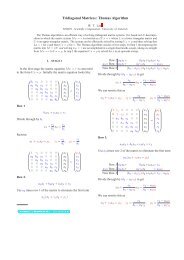Student Notes To Accompany MS4214: STATISTICAL INFERENCE
Student Notes To Accompany MS4214: STATISTICAL INFERENCE
Student Notes To Accompany MS4214: STATISTICAL INFERENCE
You also want an ePaper? Increase the reach of your titles
YUMPU automatically turns print PDFs into web optimized ePapers that Google loves.
Reparameterization<br />
Negative parameter estimates can be avoided by reparameterizing the profile log-<br />
likelihood in (2.11) using α = ln(a). Since a = e α we are guaranteed to obtain a > 0.<br />
The reparameterized profile log-likelihood becomes<br />
�<br />
n� 1<br />
ℓα(α) = mα − m ln t<br />
m<br />
eα<br />
�<br />
i + (e α − 1)<br />
implying score function<br />
and information function<br />
I(α) =<br />
i=1<br />
S(α) = m − meα � n<br />
meα �n i=1 teα i<br />
i=1 teα<br />
�n i=1 teα i<br />
�<br />
n�<br />
t eα<br />
i ln(ti) − e α [� n<br />
i=1<br />
i ln(ti)<br />
+ e α<br />
+e α<br />
m�<br />
ln (ti) − m,<br />
i=1<br />
m�<br />
ln(ti)<br />
i=1<br />
i=1 teα i ln(ti)] 2<br />
�n i=1 teα i<br />
n�<br />
i=1<br />
t eα<br />
i [ln(ti)] 2<br />
�<br />
− e α<br />
m�<br />
ln(ti).<br />
The estimates â = 1.924941 and ˆ b = 78.12213 were obtained by applying this method<br />
to the Weibull data using starting values a0 = 0.07 and a0 = 76 in 103 and 105<br />
iterations respectively. However, the starting values a0 = 0.06 and a0 = 77 failed due<br />
to division by computationally tiny (1.0e-300) values.<br />
The step-halving scheme<br />
The Newton-Raphson method uses the (first and second) derivatives of ℓ(θ) to max-<br />
imize the function ℓ(θ), but the function itself is not used in the algorithm. The<br />
log-likelihood can be incorporated into the Newton-Raphson method by modifying the<br />
updating step to<br />
θi+1 = θi + λiI(θi) −1 S(θi), (2.12)<br />
where the search direction has been multiplied by some λi ∈ (0, 1] chosen so that the<br />
inequality<br />
ℓ � θi + λiI(θi) −1 S(θi) � > ℓ (θi) (2.13)<br />
holds. This requirement protects the algorithm from converging towards minima or<br />
saddle points. At each iteration the algorithm sets λi = 1, and if (2.13) does not<br />
hold λi is replaced with λi/2. The process is repeated until the inequality in (2.13) is<br />
satisfied. At this point the parameter estimates are updated using (2.12) with the value<br />
of λi for which (2.13) holds. If the function ℓ(θ) is concave and unimodal convergence<br />
is guaranteed. Finally, when<br />
maxima is guaranteed, even if ℓ(θ) is not concave.<br />
Ī(θ) is used in place of I(θ) convergence to a (local)<br />
37<br />
i=1






